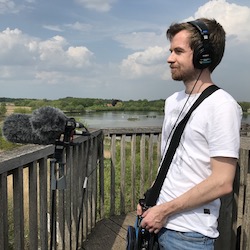

Field recording requires a different approach to recording than traditional studio recording. The environment is not controlled, and the sounds you want to capture can be unpredictable. Choosing the right microphone and recording technique can have a significant impact on the final product. The quality of the audio captured can make or break a film or project. So, it’s crucial to take the time to understand the different types of microphones and techniques available to get the best results. In this article, we’ll explore the different types of microphones and recording techniques that field recordists use to capture the best audio in a variety of outdoor environments.
There are several types of microphones that field recordists commonly use, each with its own advantages and disadvantages. Next to dynamic and condenser microphones, contact microphones are a great addition for field recording. Before we go deeper into what microphone is the best choice in which situation, we will first discuss how different microphone types work and what their advantages and disadvantages are.
Dynamic microphones are durable and can handle high sound pressure levels, making them ideal for recording loud sources like hits and impacts while being close to the object. Their unique aspect is the proximity effect. The proximity effect occurs when the microphone is placed very close to the signal and causes a warm bassy sound with nearly no ambience noise included. This is why you see engineers using microphones like the SM57 on nearly every snare and tom on a drum set or on guitar amplifiers. They are also less sensitive than other types of microphones, which can be an advantage in noisy environments. However, dynamic microphones have a limited frequency response, which will affect the quality of the recording and its range where it can be manipulated without creating artifacts.
Condenser microphones are the most commonly used ones. These microphones are known for their sensitivity and ability to capture a wide frequency range. In your beginning career a shotgun microphone and a stereo pair of small membrane cardioid microphones will mostly be your best and first choice. You have three microphones which allow you to practice the most common recording techniques and can do jobs like boom operator too without having to purchase more equipment. Shotgun microphones are a popular choice for field recordists, particularly for capturing sounds from a distance or in noisy environments. With its directional pickup pattern, a shotgun microphone is designed to capture sound from a specific direction while minimizing background noise. This makes it ideal for use in noisy or crowded environments where you want to record isolated sounds. The narrow and focused pickup pattern also allows for long-range recordings, making it possible to capture sounds from a distance without sacrificing quality. Shotgun microphones are often used in film and television production, where they can be mounted on a boom pole and pointed towards the subject. This allows for a greater degree of flexibility in capturing sound in different locations and angles. They can be used for a wide range of applications, including film and television production, wildlife recording and outdoor field recording.
However there are some drawbacks why shotgun microphones are not the best for recording source sounds which will be manipulated later in the production. Here is why: Because of their directional design, shotgun microphones can have a limited frequency range, which may not capture the full range of sound in certain environments. Overall, the benefits of using a shotgun microphone for field recording include its directional pickup pattern, long-range recording capabilities, and versatility, while its drawbacks include limited frequency range and narrow pickup pattern.
Small membrane cardioid mics like a pair of MKH 8040s mostly deliver the best results. Like shotgun microphones, cardioid microphones have a directional pickup pattern, which allows them to capture sound from a specific source while minimizing background noise. Their directional pickup pattern is wider than the shotgun mics pattern and their overall size is way smaller. That’s why they are mostly used for A/B, ORTF, LCR and XY recording techniques. You can always use a small membrane cardioid microphone but keep in mind that they can sound flat, due to their small membrane. Cheaper mics often sound muddy and are missing details in the highs, which is very impractical when it comes to manipulating those recordings. A good beginner pair is the Rode NT5 and the most commonly used but also more expensive ones are the MKH8040s by Sennheiser. Their sonic character is beautiful, their self noise level is super low and their frequency range goes from 30Hz to 50kHz. In addition to a stereo pair of MKH8040s, a center microphone like a MKH8050 or the Sanken co-100k is a great idea (another 8040 or a shotgun mic would work as well, but there are quite some disadvantages). You can mount a stereo bar to a pistol grip, place the 8040s on the bar and put the third mic in the middle. Now you can adjust the stereo width by changing the angle and distance of the MKH8040s to each other and at the same time have a clear signal for the center. The 8050 is perfect for outside recordings on days where it is a bit more windy and works well for recording quiet sounds because it has a super-cardioid capsule and captures less room noise. The Sanken is our go to microphone for indoor recordings. Its omnidirectional character captures every little detail the sound produces and gives an extreme flexibility for manipulating it later on.
Contact microphones are useful to capture the body and thump of a sound. They are placed on a surface and capture its resonation. Also they can reveal new sounds, the famous blaster sound from Star Wars is a great example. Stick your contact mic to a surface, let it ring, hit or do whatever you think is cool and see what happens. There are no rules on why and how you should use a contact mic, just be creative.
There are several reasons why you use different microphone techniques in certain situations. But to give a brief, general and overall overview here are some recommendations (for detailed insight into stereo microphone techniques read this article):
Ambiences, Walla and bigger sound sources like huge impacts:
For ambiences you want a wide and realistic sounding stereo image that comes as close to our human hearing as possible. This is why you should choose the ORTF or AB method with a stereo pair of small cardioid microphones. ORTF sounds the most realistic but a large AB can give you a bigger, wider stereo image. AB is perfect for recording impacts in a hall or explosions. The wider stereo image and the flexibility in the placement makes AB a great choice for big heavy sounds.
Smaller sound effects like hits, cracks, movement and so on:
To record smaller sounds it is a good idea to choose a LCR Setup, XY or MS setup. A mono shotgun mic would also do the job, but because we want the maximum flexibility later on, we don’t use them for recording our sfx. But if you are doing foley for a film or recordings that are not meant to be manipulated heavily later on, a shotgun mic will do the job. As described before, a pistol grip with a stereo pair of small membrane cardioid microphones mounted to the stereo bar with a 8050 or co-100k (or shotgun microphone) in the middle is very useful for when you are out in the fields. The stereo mics can be placed in ORTF or AB all depending on the situation and circumstances.
Recording vehicles is not mentioned, because this is a whole different story and takes way more details to be provided which would bomb the text’s length. We will discuss that topic in a later blog article. But overall we can say that it needs several various small membrane microphones, levs and more.
Wind protection, shock mounts and recorders
In addition to microphones, there are several other pieces of equipment that are essential for field recording. Wind protection, for example, is crucial for capturing clear audio in windy environments. A shock mount can also be used to reduce handling noise and vibrations, while a good preamp is highly valuable due to its low self noise level and the way it compresses and enriches the signal. There are reasons why sound engineers love the sound of a Neve, Focusrite or other famous preamp. The MixPre-6 is the most used in field recording and one of the best multitrack recorders that get our job done well.
Field recording is a complex process that requires understanding and adapting to unpredictable environments. The choice of the right equipment and techniques can significantly enhance the quality of the recordings, resulting in stunning audio experiences.

Jonas, co-founder of Just Sound Effects, is a graduated sound designer and captures field recordings all over the world, always looking for unique soundscapes and new places to explore.

All prices are net, additional VAT may apply.
By subscribing to our newsletter you agree to our privacy policy.

All prices are net, additional VAT may apply.
© 2025 JUST SOUND EFFECTS GbR – All rights reserved
By subscribing to our newsletter you agree to our privacy policy.